Q: In the book Clicking with Your Dog, and on this website, the method to train a good "come" is discussed. In both places, you start out using the "come" command as the cue. Why is this training strategy different than others, where you add the cue after the dog knows the behavior?
Al Boeck
Blue Springs, MO
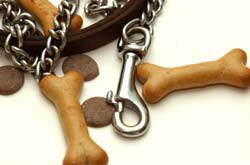
A: Excellent question, Al.
In general, most dogs already have the behavior of coming to you when they want to. Teaching them a word for coming (over very short distances, i.e., around the house) when YOU want them to is OK because you already have the behavior, you are just adding a cue. In the "old days" (the '90s) we thought you needed to completely develop the shaped behavior before adding the cue, but now we know you can continue to shape for duration, distance, and distractions, even though you have named the behavior.
A refinement that is not available in Clicking with Your Dog, Step by Step in Pictures, or on the website discussion of "come," is this: Get a good "come" behavior; add the "come" cue; shape for distance, speed of arrival, and coming with distractions (squirrels in the park being the Graduate School Level); and then replace the "training" come cue with a "performance-level" come cue, such as a whistle or other sound...you'll then have a bomb-proof long-distance recall.
You might want to shape itty-bitty recalls in class, as you begin to build your "come" cues.In our PetCo curriculum we have three-foot, dog-to-owner on-leash recalls to start with, with the instructor following the dog, holding the leash, and preventing bolting if necessary. But we do use the cue from the start, as well; we just try to make each "come" successful, clicked right on time (instructor does the clicking at first) and well reinforced with high-value treats, not just praise.


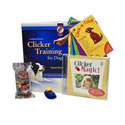
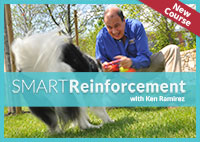
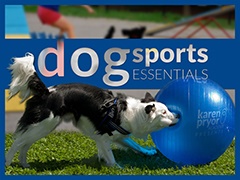

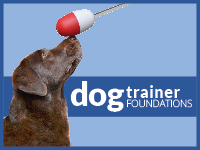

will not come when out and when sees other dogs
Hi
We've just adopted an 1 year old alaskan malamute/labrador mix. He's generally well trained for his age, and listens 95 % of the time at home also when I train recall with him, but when we're out, and he sees something interesting incl. other dogs, he goes totally deaf. I've started clicker training him, but he doesn't seem to interested in it yet.
What can we do?
Mia
Premack Principle
Another good method to add to recall as well as the come command is the premack principle. this is used when the dog is doing something he finds fun. you call him, and you reward but immediately say okay go play and release him to the activity he was doing before, as it will teach them that you are not trying to interrupt their play.
other problems in training today is that people call their dogs to punish them, or to get them to come from doing something fun like the dog park for example. you have to get the dog without calling him. that is a big no no as it will make the dog not want to come to you, and could make things unsafe. you want to always be in a happy mood and make yourself a positive encounterance from day 1.
recall and distraction
Hi folks,
I've just adopted a 3 year old cattle dog x bull terrier x GSD (+ another 50 or so breeds!) bitch from a rescue society. She's built like a cattle dog, so super fast and likes to cover distance. She's got the cattle dog smarts but the bull terrier determination / stubborness. She was pretty well trained when she came to us, but we're facing one or two challenges. She's a bit ball focussed, we don't want this to turn into an obsession so tried not to play with the ball so much on walks and would try to get her range around and explore off leash a bit. This has now backfired and she's turned into squirrel hunter extraordinaire. We have a clicker and I am starting target training with a view to using it to help recalls - probably using a whistle outside instead.
I don't really want to walk her on leash when we are on the trails, she's a super high energy dog who I genuinely believe needs the freedom to range to burn off the energy. We walk her or run her for at least 3 hours a day.
Any suggestions for how to incorporate recall training into our existing schedule out in the field?
you could try running on
you could try running on top of food as the reward for coming. Dogs usually love chasing games, you just need to reverse the roles to have a come. I would start inside, without nothing better to compete with my treats (and maybe howtdogs are not good enough? Try beef liver fried on a pan with olive oil or salmon from your dinner, or ham?). I show the dog I have a bunch of good stuff and, facing the same direction as him, run away a bit from him, as soon as he follows a step or two I click and give him a piece and run away again. Soon the dog is running after me and eating treats gladly. Sometimes I run faster and turn often before I let him catch me because he will get excited over that. Much more fun then just come and eat a treat.
I also make sur it is worth everytime to come during the first months. Then the dog does not devlop the 'hmmm, is it worth it this time?' . He knows it is so he just comes. Later I can vary reinforcers to non food reinforcers easily. Often just running after me is fun enough.
Come!
Hey Sparky,
Don't be discouraged about your 6 mo old pup doing that. I have raised many puppies in the past 10 yrs and all of them go through a stage where they think coming to you is not as fun as going the other way. Try using voice signals like rolling your tongue and raising your voice, then walk away from the dog. When she comes towards you-to investigate the strange sound compliment her with a click and a treat. At first she will come our of curriosity. You may even try to get her to chase you and then slow down, let her catch up. This is then when you click to give a reward. Hope this is helpful. Right now she is still equivalent to a 1-2 yr old child. Remember, they don't come to you always either. You will see a much improved dog at 1 yr of age when they are more into pleasing you than investigating their surroundings.
Sona
recall
hi guys, my little working english cocker spaniel's recall is good most of the time but when she gets on a scent of an animal she is off can you offer advice Irma
come!
My Pembroke welsh corgi (a purebred) is now 6 months old and won't come! We have tried everything, we get going with clicker training and he gets the hang of it but, sooner or later he doesn't want his hot dogs and stops to snorrfle on the ground. My brother and I unfortunately have taught him a tag game where we chase him and he loves it! But, now he won't come and we have had him for 3 months and we are at our wits end. When you call him he sits there and looks at you and tries to decide to come and if he decides yes, he stops and sniffs everything on the ground. He is really smart and looks to see if you have a treat in your hand. If he think you do he comes a little closer and sniffs. If he can't smell anything he runs away. Please help!!!!
~Becky
no sweat
Geeze, I typed out an entire essay on how to correct that behaviour and how I built off the leash reliability for the command "come" with my pup. Eventually realized I might get flamed by some of the users here so deleted the whole thing lol.
Let me know and I could email you, its upto u however if u'd like to use the method or not. Its non-cruel, just makes extensive use of a crate and clicker :)
recall
Hi Backy,
have you ever heard about calming signals? Your dog, sitting, sniffing is trying to calm you...try to use a more calm and inviting voice, don't get hungry, reward him when he cames, plays with him... he could be happy to come to you. There are many books about calming signals, very interesting
Michela
Post new comment